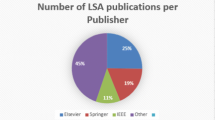Abstract
This paper proposes a novel approach which uses a multi-objective evolutionary algorithm based on decomposition to address the ontology alignment optimization problem. Comparing with the approach based on Genetic Algorithm (GA), our method can simultaneously optimize three goals (maximizing the alignment recall, the alignment precision and the f-measure). The experimental results shows that our approach is able to provide various alignments in one execution which are less biased to one of the evaluations of the alignment quality than GA approach, thus the quality of alignments are obviously better than or equal to those given by the approach based on GA which considers precision, recall and f-measure only, and other multi-objective evolutionary approach such as NSGA-II approach. In addition, the performance of our approach outperforms NSGA-II approach with the average improvement equal to 32.79 \(\%\). Through the comparison of the quality of the alignments obtained by our approach with those by the state of the art ontology matching systems, we draw the conclusion that our approach is more effective and efficient.



Similar content being viewed by others
References
Acampora G, Loia V, Salerno S (2012) A hybrid evolutionary approach for solving the ontology alignment problem. Int J Intell Syst 27:189–216
Aumueller D, Do HH, Massmann S (2005) Schema and ontology matching with COMA++. In: Proceedings of the 2005 ACM SIGMOD international conference on management of data, pp 906–908
Bock J, Hettenhausen J (2012) Discrete particle swarm optimisation for ontology alignment. Inf Sci 192:152–173
David J, Guillet F, Briand H (2006) Matching directories and OWL ontologies with AROMA. In: Proceedings of the 15th ACM international conference on information and knowledge management, pp 830–831
Deb K, Agrawal S, Pratap A (2000) A fast elitist non-dominated sorting genetic algorithm for multi-objective optimization: NSGA-II. In: Proceedings of the parallel problem solving from nature VI conference, vol 1917, pp 849–858
Deb K, Gupta S (2010) Towards a link between knee solutions and preferred solution methodologies. Swarm, evolutionary, and, memetic computing, pp 182–189
Do HH, Rahm E (2002) COMA a system for flexible combination of schema matching approaches. In: Proceeding of the 28th international VLDB conference, pp 610–621
Drumm C, Schmitt M, Do HH (2007) Quickming: automatic schema matching for data migration projects. In: Proceeding of the sixteenth ACM conference on information and knowledge management, pp 107–116
Euzenat J, Shvaiko P (2007) Ontology matching. Springer, Berlin
Gal A, Anaby-Tavor A, Trombetta A (2005) A framework for modeling and evaluating automatic semantic reconciliation. VLDB J 14:50–67
Garcia S, Molina D, Lozano M, Herrera F (2009) A study on the use of non-parametric tests for analyzing the evolutionary algorithm behaviour: a case study on the CEC2005 Special Session on Real Parameter Optimization. J Heurist 15:617–644
Ginsca A-L, Iftene A (2010) Using a genetic algorithm for optimizing the similarity aggregation step in the process of ontology alignment. 9th Roedunet Int Conf. (RoEduNet), pp 118–122
Giunchiglia F, Shvaiko P, Yatskevich M, Briand H (2005) S-Match: an algorithm and an implementation of semantic matching. Semantic interoperability and integration, number 04391 in Dagstuhl seminar proceedings, Dagstuhl
Gruber TR (1993) A translational approach to portable ontology specifications. Knowl Acquisit 5:199–220
Li J, Tang J, Li Y, Luo Q (2009) RiMOM: a dynamic multistrategy ontology alignment framework. IEEE Trans Knowl Data Eng 21:1218–1232
Maedche A, Staab S (2002) Measuring similarity between ontologies. In: Proceedings of the international conference on knowledge engineering and, knowledge management (EKAW), pp 251–263
Marjit U, Mandal M (2012) Multiobjective particle swarm optimization based ontology alignment. 2012 2nd IEEE international conference on parallel distributed and grid computing (PDGC), pp 368–373
Martinez-Gil J, Alba E, Aldana-Montes JF (2008) Optimizing ontology alignments by using genetic algorithms. Nature Inspired Reasoning for the Semantic Web (NatuReS2008), vol 419, pp 31–45
Mascardi V, Locoro A, Rosso P, Briand H (2010) Automatic ontology matching via upper ontologies: a systematic evaluation. IEEE Trans Knowl Data Eng 22:609–623
Miller GA (1995) WordNet: a lexical database for English. Commun ACM 38:39–41
Milton JS, Arnold JC (1990) Introduction to probability and statistics: principles and applications for engineering and the computing sciences. McGraw-Hill, New York
Naya JMV, Romero MM, Loureiro JP (2010) Improving ontology alignment through genetic algorithms. In: Soft computing methods for practical environment solutions: techniques and, studies, pp 240–259
Ontology Alignment Evaluation Initiative (OAEI) (2011). http://oaei.ontologymatching.org/2011/ (Accessed 15 May 2012)
Van Rijsbergen CJ (1974) Foundation of evaluation. J Document 34:365–373
Slim B, Said LB, Ghdira K (2011) Searching for knee regions of the Pareto front using mobile reference points. Soft Comput 15:1807–1823
Wang J, Ding Z, Jiang C (2006) GAOM: genetic algorithm Based ontology matching. In: Proceedings of the IEEE Asia-Pacific conference on services computing (APSCC), pp 617–620
Zhang QF, Li H (2007) MOEA/D: a multiobjective evolutionary algorithm based on decomposition. Evol Comput 11:712–731
Acknowledgments
This work is supported by the National Natural Science Foundation of China (No. 61272119).
Author information
Authors and Affiliations
Corresponding author
Additional information
Communicated by E. Viedma.
Rights and permissions
About this article
Cite this article
Xue, X., Wang, Y. & Hao, W. Using MOEA/D for optimizing ontology alignments. Soft Comput 18, 1589–1601 (2014). https://doi.org/10.1007/s00500-013-1165-9
Published:
Issue Date:
DOI: https://doi.org/10.1007/s00500-013-1165-9




